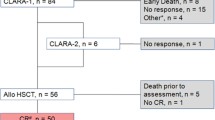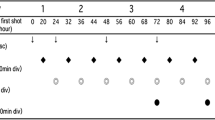Abstract
Patients with primary refractory or early relapsed acute myeloid leukemia (AML) have a dismal prognosis, and the treatment options for these patients are limited. The present study retrospectively examined the efficacy and toxicities of the combination of cladribine 5 mg/m2 per day and intermediate-dose cytarabine 1 g/m2 per day for 5 days and granulocyte colony–stimulating factor (G-CSF) as a salvage treatment in 36 patients with relapsed/refractory AML. Among these, 32 patients had de novo AML, and the remaining 4 patients had secondary AML. The median age for the study cohort was 45.8 years. According to the European LeukemiaNet prognostic index, 5 patients had favorable risk, 18 had intermediate risk, and 11 had poor risk. The complete remission was achieved in 58% of the patients with tolerable toxicities. Fifteen patients underwent stem cell transplantation later. Patients who underwent allogeneic hematopoietic stem cell transplantation had a significantly improved 1-year overall survival compared with those who did not (73% vs. 29%, P < 0.001). The results suggested that, as a salvage regimen, modified cladribine, cytarabine, and G-CSF were effective and well tolerated for patients with relapsed/refractory AML, especially for patients who underwent subsequent stem cell transplantation.


Similar content being viewed by others
References
Edenfield WJ, Gore SD (1999) Stage-specific application of allogeneic and autologous marrow transplantation in the management of acute myeloid leukemia. Semin Oncol 26:21–34
Robak T, Wrzesień-Kuś A (2002) The search for optimal treatment in relapsed and refractory acute myeloid leukemia. Leuk Lymphoma 43:281–291. https://doi.org/10.1080/10428190290006053
Breems DA, Van Putten WL, Huijgens PC et al (2005) Prognostic index for adult patients with acute myeloid leukemia in first relapse. J Clin Oncol 23:1969–1978. https://doi.org/10.1200/JCO.2005.06.027
Fiegl M, Unterhalt M, Kern W et al (2014) Chemomodulation of sequential high-dose cytarabine by fludarabine in relapsed or refractory acute myeloid leukemia: a randomized trial of the AMLCG. Leukemia 28:1001–1007. https://doi.org/10.1038/leu.2013.297
Biggs JC, Horowitz MM, Gale RP, Ash RC, Atkinson K, Helbig W, Jacobsen N, Phillips GL, Rimm AA, Ringdén O (1992) Bone marrow transplants may cure patients with acute leukemia never achieving remission with chemotherapy. Blood 80:1090–1093
Craddock C, Labopin M, Pillai S, Finke J, Bunjes D, Greinix H, Ehninger G, Steckel NK, Zander AR, Schwerdtfeger R, Buchholz S, Kolb HJ, Volin L, Fauser A, Polge E, Schmid C, Mohty M, Rocha V (2011) Factors predicting outcome after unrelated donor stem cell transplantation in primary refractory acute myeloid leukaemia. Leukemia 25:808–813. https://doi.org/10.1038/leu.2011.13
Gandhi V, Estey E, Keating MJ et al (1996) Chlorodeoxyadenosine and arabinosylcytosine in patients with acute myelogenous leukemia: pharmacokinetic, pharmacodynamic, and molecular interactions. Blood 87:256–264
Hubeek I, Peters GJ, Broekhuizen AJ et al (2005) Potentiation of in vitro ara-C cytotoxicity by ribonucleotide reductase inhibitors, cyclin-dependent kinase modulators and the DNA repair inhibitor aphidicolin in paediatric acute myeloid leukaemia. Br J Haematol 131:219–222. https://doi.org/10.1111/j.1365-2141.2005.05760.x
Chow KU, Boehrer S, Napieralski S, Nowak D, Knau A, Hoelzer D, Mitrou PS, Weidmann E (2003) In AML cell lines Ara-C combined with purine analogues is able to exert synergistic as well as antagonistic effects on proliferation, apoptosis and disruption of mitochondrial membrane potential. Leuk Lymphoma 44:165–173. https://doi.org/10.1080/1042819021000054670
Robak T, Wrzesień-Kuś A, Lech-Marańda E et al (2000) Combination regimen of cladribine (2-chlorodeoxyadenosine), cytarabine and G-CSF (CLAG) as induction therapy for patients with relapsed or refractory acute myeloid leukemia. Leuk Lymphoma 39:121–129
Wrzesień-Kuś A, Robak T, Lech-Marańda E, Wierzbowska A, Dmoszyńska A, Kowal M, Hołowiecki J, Kyrcz-Krzemień S, Grosicki S, Maj S, Hellmann A, Skotnicki A, Jedrzejczak W, Kuliczkowski K, Polish Adult Leukemia Group (2003) A multicenter, open, non-comparative, phase II study of the combination of cladribine (2-chlorodeoxyadenosine), cytarabine, and G-CSF as induction therapy in refractory acute myeloid leukemia - a report of the Polish Adult Leukemia Group (PALG). Eur J Haematol 71:155–162
Burnett AK, Russell NH, Hills RK, Hunter AE, Kjeldsen L, Yin J, Gibson BES, Wheatley K, Milligan D (2013) Optimization of chemotherapy for younger patients with acute myeloid leukemia: results of the medical research council AML15 trial. J Clin Oncol 31:3360–3368. https://doi.org/10.1200/JCO.2012.47.4874
Löwenberg B, Pabst T, Vellenga E, van Putten W, Schouten HC, Graux C, Ferrant A, Sonneveld P, Biemond BJ, Gratwohl A, de Greef GE, Verdonck LF, Schaafsma MR, Gregor M, Theobald M, Schanz U, Maertens J, Ossenkoppele GJ (2011) Cytarabine dose for acute myeloid leukemia. N Engl J Med 364:1027–1036. https://doi.org/10.1056/NEJMoa1010222
Löwenberg B (2013) Sense and nonsense of high-dose cytarabine for acute myeloid leukemia. Blood 121:26–28. https://doi.org/10.1182/blood-2012-07-444851
Joerger M, Bosch TM, Doodeman VD, Beijnen JH, Smits PHM, Schellens JHM (2006) Novel deoxycytidine kinase gene polymorphisms: a population screening study in Caucasian healthy volunteers. Eur J Clin Pharmacol 62:681–684. https://doi.org/10.1007/s00228-006-0162-7
Vardiman JW, Thiele J, Arber DA, Brunning RD, Borowitz MJ, Porwit A, Harris NL, le Beau MM, Hellstrom-Lindberg E, Tefferi A, Bloomfield CD (2009) The 2008 revision of the World Health Organization (WHO) classification of myeloid neoplasms and acute leukemia: rationale and important changes. Blood 114:937–951. https://doi.org/10.1182/blood-2009-03-209262
Döhner H, Estey E, Grimwade D, Amadori S, Appelbaum FR, Büchner T, Dombret H, Ebert BL, Fenaux P, Larson RA, Levine RL, Lo-Coco F, Naoe T, Niederwieser D, Ossenkoppele GJ, Sanz M, Sierra J, Tallman MS, Tien HF, Wei AH, Löwenberg B, Bloomfield CD (2017) Diagnosis and management of AML in adults: 2017 ELN recommendations from an international expert panel. Blood 129:424–447. https://doi.org/10.1182/blood-2016-08-733196
Megías-Vericat JE, Martínez-Cuadrón D, Sanz MÁ, Montesinos P (2018) Salvage regimensusing conventional chemotherapy agents for relapsed/refractory adult AML patients: a systematic literature review. Ann Hematol 97:1115–1153. https://doi.org/10.1007/s00277-018-3304-y
Wierzbowska A, Robak T, Pluta A, Wawrzyniak E, Cebula B, Hołowiecki J, Kyrcz-Krzemień S, Grosicki S, Giebel S, Skotnicki AB, Piątkowska-Jakubas B, Kuliczkowski K, Kiełbiński M, Zawilska K, Kłoczko J, Wrzesień-Kuś A (2008) Cladribine combined with high doses of arabinoside cytosine, mitoxantrone, and G-CSF (CLAG-M) is a highly effective salvage regimen in patients with refractory and relapsed acute myeloid leukemia of the poor risk: a final report of the Polish Adult Leukemia Group. Eur J Haematol 80:115–126. https://doi.org/10.1111/j.1600-0609.2007.00988.x
Giles F, Vey N, DeAngelo D, Seiter K, Stock W, Stuart R, Boskovic D, Pigneux A, Tallman M, Brandwein J, Kell J, Robak T, Staib P, Thomas X, Cahill A, Albitar M, O’Brien S (2009) Phase 3 randomized, placebo-controlled, double-blind study of high-dose continuous infusion cytarabine alone or with laromustine (VNP40101M) in patients with acute myeloid leukemia in first relapse. Blood 114:4027–4033. https://doi.org/10.1182/blood-2009-06-229351
Faderl S, Wetzler M, Rizzieri D, Schiller G, Jagasia M, Stuart R, Ganguly S, Avigan D, Craig M, Collins R, Maris M, Kovacsovics T, Goldberg S, Seiter K, Hari P, Greiner J, Vey N, Recher C, Ravandi F, Wang ES, Vasconcelles M, Huebner D, Kantarjian HM (2012) Clofarabine plus cytarabine compared with cytarabine alone in older patients with relapsed or refractory acute myelogenous leukemia: results from the CLASSIC I Trial. J Clin Oncol 30:2492–2499. https://doi.org/10.1200/JCO.2011.37.9743
Bergua JM, Montesinos P, Martinez-Cuadrón D, Fernández-Abellán P, Serrano J, Sayas MJ, Prieto-Fernandez J, García R, García-Huerta AJ, Barrios M, Benavente C, Pérez-Encinas M, Simiele A, Rodríguez-Macias G, Herrera-Puente P, Rodríguez-Veiga R, Martínez-Sánchez MP, Amador-Barciela ML, Riaza-Grau R, Sanz MA, the PETHEMA group (2016) A prognostic model for survival after salvage treatment with FLAG-Ida +/−gemtuzumab-ozogamicine in adult patients with refractory/relapsed acute myeloid leukaemia. Br J Haematol 174:700–710. https://doi.org/10.1111/bjh.14107
Wattad M, Weber D, DÖ hner K et al (2017) Impact of salvage regimens on response and overall survival in acute myeloid leukemia with induction failure. Leukemia 31:1306–1313. https://doi.org/10.1038/leu.2017.23
Libura M, Giebel S, Piatkowska-Jakubas B, Pawelczyk M, Florek I, Matiakowska K, Jazwiec B, Borg K, Solarska I, Zawada M, Czekalska S, Libura J, Jakobczyk M, Karabin K, Paluszewska M, Calbecka M, Gajkowska-Kulik J, Gadomska G, Kielbinski M, Ejduk A, Kata D, Grosicki S, Wierzbowska A, Kyrcz-Krzemien S, Warzocha K, Kuliczkowski K, Skotnicki A, Holowiecki J, Jedrzejczak WW, Haus O (2016) Cladribine added to daunorubicin-cytarabine induction prolongs survival of FLT3-ITD+ normal karyotype AML patients. Blood 127:360–362. https://doi.org/10.1182/blood-2015-08-662130
Walter RB, Buckley SA, Pagel JM, Wood BL, Storer BE, Sandmaier BM, Fang M, Gyurkocza B, Delaney C, Radich JP, Estey EH, Appelbaum FR (2013) Significance of minimal residual disease before myeloablative allogeneic hematopoietic cell transplantation for AML in first and second complete remission. Blood 122:1813–1821. https://doi.org/10.1182/blood-2013-06-506725
Bastos-Oreiro M, Perez-Corral A, Martínez-Laperche C, Bento L, Pascual C, Kwon M, Balsalobre P, Muñoz C, Buces E, Serrano D, Gayoso J, Buño I, Anguita J, Diéz-Martín JL (2014) Prognostic impact of minimal residual disease analysis by flow cytometry in patients with acute myeloid leukemia before and after allogeneic hemopoietic stem cell transplantation. Eur J Haematol 93:239–246. https://doi.org/10.1111/ejh.12336
Xiao H, Li L, Pang Y, Wu Y, Jiang Z, Liu Z, Wu J, Xiao Y, Huang F, Liu Q, Zhang H, Luo Y, Huang H (2018) Sequential treatment combining cladribine-based re-induction, myeloablative allogeneic HSCT, and prophylactic donor lymphocyte infusion: a promising treatment for refractory acute myeloid leukemia. Ann Hematol 97:2479–2490. https://doi.org/10.1007/s00277-018-3453-z
Acknowledgments
The authors appreciate the assistance of Chao Hu in collecting and preliminarily processing specimens from some patients and the contribution of Feifei Chen in revising and correcting the manuscript.
Funding
This study was funded by the National Natural Science Foundation of China (81500127), the Zhejiang Provincial Medical and Health Science and Technology Project (2017KY144), and the Ningbo Yinzhou District Social and Development project (YZ2015-96), China.
Author information
Authors and Affiliations
Corresponding author
Ethics declarations
Conflict of interest
The authors declare that they have no conflict of interest.
Ethical approval
This study was conducted in accordance with the principles of the Declaration of Helsinki and approved by the ethics committee of the institution.
Additional information
Publisher’s note
Springer Nature remains neutral with regard to jurisdictional claims in published maps and institutional affiliations.
Rights and permissions
About this article
Cite this article
Ye, P., Pei, R., Jin, J. et al. Modified cladribine, cytarabine, and G-CSF as a salvage regimen in patients with relapsed/refractory acute myeloid leukemia: a bridge to myeloablative allogeneic hematopoietic stem cell transplantation. Ann Hematol 98, 2073–2080 (2019). https://doi.org/10.1007/s00277-019-03723-w
Received:
Accepted:
Published:
Issue Date:
DOI: https://doi.org/10.1007/s00277-019-03723-w




